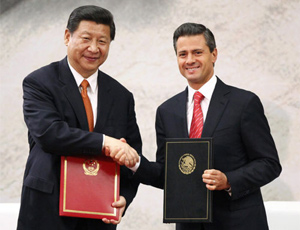China & Mexico Talk of Strategic Partnership Deal, But Much Remains to be Done
Op-Ed Commentary: Chris Devonshire-Ellis
 Jun. 7 – Chinese President Xi Jinping has been in Mexico the past three days and has been meeting with the Mexican President Enrique Peña Nieto ahead of Xi’s much anticipated visit to meet President Barack Obama of the United States. Xi and Peña Nieto, following their meetings, released a statement saying that both were prepared to “take their relationship to a new level” and to develop the existing trade relationship into a “strategic partnership,” suggesting that both countries could form mutually beneficial commercial alliances in the form of joint ventures. That makes some sense to the extent that Mexico is a member of the North American Free Trade Agreement – which also includes the United States and Canada.
Jun. 7 – Chinese President Xi Jinping has been in Mexico the past three days and has been meeting with the Mexican President Enrique Peña Nieto ahead of Xi’s much anticipated visit to meet President Barack Obama of the United States. Xi and Peña Nieto, following their meetings, released a statement saying that both were prepared to “take their relationship to a new level” and to develop the existing trade relationship into a “strategic partnership,” suggesting that both countries could form mutually beneficial commercial alliances in the form of joint ventures. That makes some sense to the extent that Mexico is a member of the North American Free Trade Agreement – which also includes the United States and Canada.
Therefore, the prospect of Chinese companies seeking partnerships with Mexican businesses to then sell onto the lucrative U.S. market looms large. But does it? The two leaders released a statement suggesting that Chinese-Mexican bilateral relations would enter into a new phase and were “being upgraded.” Xinhua published the official statement through China Daily that, in condensed form, promised both sides “will view their relations from a strategic and long-term perspective” and “accommodate each other’s concerns.” Along with that are statements to “maintain exchanges between high-level leaders and political parties,” as well as “agree to increase mutual investment in key areas such as energy, mining, infrastructure and high technology.”
China has stated it “supports the increase of imports from Mexico, while Mexico welcomes Chinese enterprises to invest in Mexico and promises to create favorable conditions for Chinese investors.” Frankly, Mexico needs to address the issue. Current Mexico-China trade figures for 2012 show an imbalance of some US$50 billion in China’s favor and according to the Mexican Central Bank, Mexico imported US$57 billion worth of Chinese goods last year, while Mexico sold just US$5.7 billion to China. Although China is Mexico’s second largest trade partner, and therefore important, the size of the two economies and populations should also be taken into account. With Mexico sporting a population of about 115 million against China’s 1.3 billion, it means that Mexico purchases Chinese goods at a value of US$496 per capita, while China averages US$4 per capita in buying Mexican goods. That’s a sizable disparity.
However, the two countries did agree to “improve cultural exchanges.” The Chinese will apparently build a Chinese cultural center in Mexico City, the first in Latin America and the Caribbean, and Mexico will establish a Mexican cultural center in Beijing. Finally the communiqué said that “China and Mexico will improve multilateral coordination based on their common interests and responsibilities on major international issues.” Xi left Mexico with the promise of Chinese contracts “worth US$1 billion,” but without any details of where these would be from or in what form.
If there was substance to these declarations of “strategic partnership” then we would potentially be in the wonderfully ironic position of Chinese companies, through Mexican JVs, qualifying for the U.S.-led Trans-Pacific Partnership Agreement, a trade bloc that includes Mexico and Vietnam, among others, and is largely aimed at replacing China as the primary supplier of choice for certain products (such as textiles) for the U.S. market. Yet, sadly, I feel that is not going to happen.
These sorts of meetings, in my opinion, are an excuse for political grandstanding and media exposure. As a result, they mean very little. While the prospect of Mexican-Chinese JVs to target the U.S. market may seem appealing to both, in actual fact, the Chinese side have little incentive to do so. Mexico has no double taxation agreement (DTA) with China, meaning that Chinese investors are subject to Mexican rates of corporate income tax (CIT) and related taxes with no treaty to offset these.
Mexico has a higher rate of CIT at 28 percent than China at 25 percent. Although that doesn’t sound like a huge difference – it is more than enough to eat into any available profit gains in such competitive markets. Mexico also levies immediate worldwide income tax claims on all residents – something that is not likely to sit well with Chinese investors.
The two countries do have an “Agreement between the Government of the United Mexican States and the Government of the Peoples Repubic of China on the Promotion and Reciprocal Protection of Investments,” however this dates back to 2008 and the current statements do little, if anything, to expand beyond the framework within. That was penned five years ago at the time of Beijing hosting the Olympics. So this could simply be another example of an agreement written by Mexico to feed their hungry media and to show off their politicians alongside countries that are firmly in the international spotlight, because it contains little of actual substance. So what does the rhetoric actually mean? From the U.S. perspective, probably not a lot. Without any supporting tax agreements, the Mexico-China talk remains just that – talk. Chinese companies have access to U.S. markets anyway and the Mexican tax code is unattractive to them compared with lower rates back in China.
That said about Mainland China, the news may yet be of use to Hong Kong’s business community. Hong Kong signed a comprehensive DTA with Mexico on June 18, 2012 which entered into force on March 7, 2013 and will have effect in Hong Kong for years of assessment beginning on or after April 1, 2014. Under the terms of the DTA, the current policy of double-taxing Mexican individuals who are resident in Hong Kong will end, and any tax paid in Mexico will be considered a tax credit against the tax payable to Hong Kong. The DTA also incorporates the Organization for Economic Cooperation and Development requirements for the exchange of tax information. Specifically, the DTA lowers rates of withholding taxes in the contracting state in which the income is derived, in respect of dividends, interest and royalties. While dividend income is only taxable in the country of the recipient, interest income can be taxed in both territories. But in the territory where the interest income arises, withholding tax will be capped at 4.9 percent if the beneficial owner is a bank, and at 10 percent when the recipient is the beneficial owner of the asset from which interest income is derived. If the recipient is the beneficial owner of royalties income, the withholding tax rate will be capped at 10 percent.
What this really boils down to is that while Mexico may not have been able to extract many concessions from the bigger prize of mainland Chinese consumers, it may be able to better sell through Hong Kong importers and distributors with links to Mainland China. The Mexican stand off? It’ll be the Hong Kong distributors with their connections in the mainland that will benefit most, not the Mexican exporters, although no doubt some increase in Mexican trade will manifest itself in Hong Kong’s trade figures.
A real deal with meaningful language concerning China bilateral trade would have included discussions on negotiating a bilateral double tax treaty. The fact that it didn’t suggests that while both President Xi and President Peña Nieto may want to target the U.S. consumer market, the tax structural ability to actively do so as trade partners remains elusive, and Mexico has to settle instead for a small increase of exports to Hong Kong. Future statements and agreements to cooperate will need to be much deeper than those just released by both presidents to make any impact on that US$50 billion trade gap, or for either to jointly target the U.S. market.
Chris Devonshire-Ellis is the principal and founding partner of Dezan Shira & Associates. The firm provides investment legal and cross border tax advice to mid-cap MNCs from the United States and Europe into China and Asia, and maintains a North American liaison office in Charlotte, North Carolina. For more information please email china@dezshira.com or view the practice website at www.dezshira.com.
Related Reading
 Sourcing from China
Sourcing from China
In this issue of China Briefing Magazine, we outline the various sourcing models available for foreign investors and discuss how to decide which structure best suits the sourcing needs of your business. Perhaps the most important factors to consider when choosing a sourcing structure are your staffing requirements, your need for operational flexibility, and which option offers the greatest cost efficiencies.
 Trading with China
Trading with China
This issue of China Briefing Magazine focuses on the minutiae of trading with China – regardless of whether your business has a presence in the country or not. Of special interest to the global small and medium-sized enterprises, this issue explains in detail the myriad regulations concerning trading with the most populous nation on Earth – plus the inevitable tax, customs and administrative matters that go with this.
 ASEAN Briefing
ASEAN Briefing
Our new website featuring thousands of downloadable double taxation agreements, free trade agreements, and bilateral investment treaties involving ASEAN nations, including those with China.
- Previous Article China Releases Draft on WTO Trade Remedies and Dispute Settlements
- Next Article MOC: China is Mulling E-Commerce Tax


























